Transmission Replacement LA1
Tools Required
J 35944-A Transmission Oil Cooler Flusher
Removal Procedure
Important: Transmission oil circulates between the transmission assembly and the transfer case. In situations where transmission related failures circulate debris into the transfer case, the transfer case must be disassembled, cleaned, and inspected for damage.
- Remove the push pins from the coolant recovery bottle.
- Position aside the coolant recovery bottle.
- Remove the air cleaner. Refer to Air Cleaner Assembly Replacement in Engine Controls-3.4L.
- Remove the automatic transmission range selector cable from the automatic transmission range selector cable lever. Refer to Automatic Transmission Range Selector Lever Replacement .
- Remove the automatic transmission range selector cable bracket. Refer to Range Selector Lever Cable Bracket Replacement .
- Disconnect the wiring harness connectors from the transaxle.
- Remove the wiring harness from the transaxle.
- Remove the right side engine strut. Refer to Engine Mount Strut Replacement - Right Side in Engine Mechanical-3.4L.
- Install the engine support fixture. Refer to Engine Support Fixture in Engine Mechanical-3.4L.
- Raise the vehicle. Refer to Lifting and Jacking the Vehicle in General Information.
- Remove the top four bell housing bolts (2, 3, 4, 5).
- If the vehicle is equipped with All-Wheel-Drive (AWD), perform the following steps:
- Remove the frame. Refer to Front Frame Replacement in Frame and Underbody.
- Remove the filler tube. Refer to Transmission Fluid Filler Tube Replacement .
- Remove the torque converter cover. Refer to Torque Converter Cover Replacement .
- Remove the torque converter bolts. Refer to Flywheel to Torque Converter Bolt Replacement .
- Disconnect the vehicle speed sensor electrical connector.
- Remove the right and left drive axles from the transaxle. Refer to Front Wheel Drive Shaft Replacement in Wheel Drive Shafts.
- Disconnect the transmission cooler hoses from the transaxle. Refer to Automatic Transmission Oil Cooler Hose Replacement .
- Position the transmission jack under the transaxle.
- Remove the transaxle / transfer case brace. Refer to Transmission Brace Replacement .
- Remove the lower transaxle bolts (6) and stud (1).
- Remove the transaxle from the vehicle.
- If the vehicle is equipped with AWD, remove the transfer case. Refer to Transfer Case Removal in Automatic Transaxle - 4T65-E Unit Repair.
- Flush the transaxle oil cooler and the transaxle oil cooler hoses. Refer to Transmission Fluid Cooler Flushing and Flow Test in Automatic Transmission - 4T65-E.

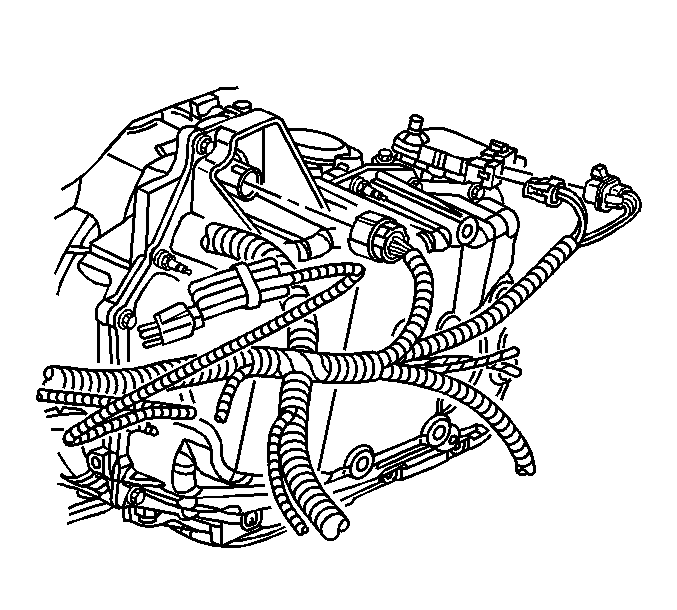
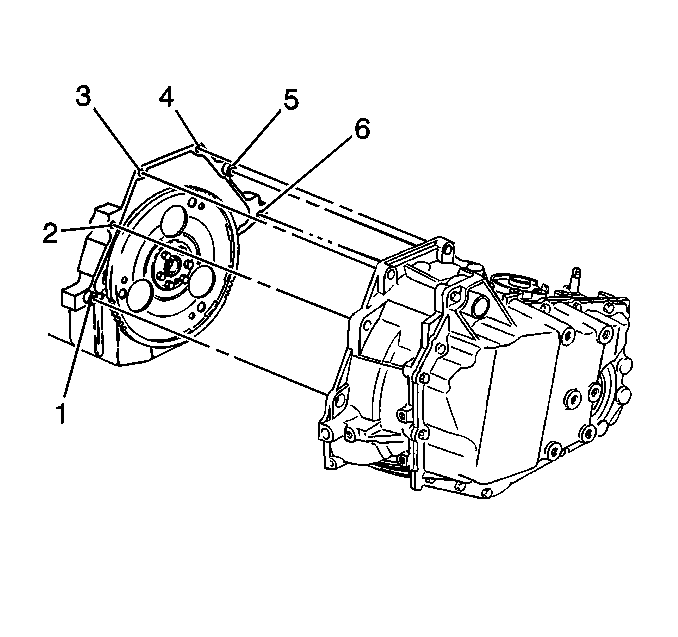
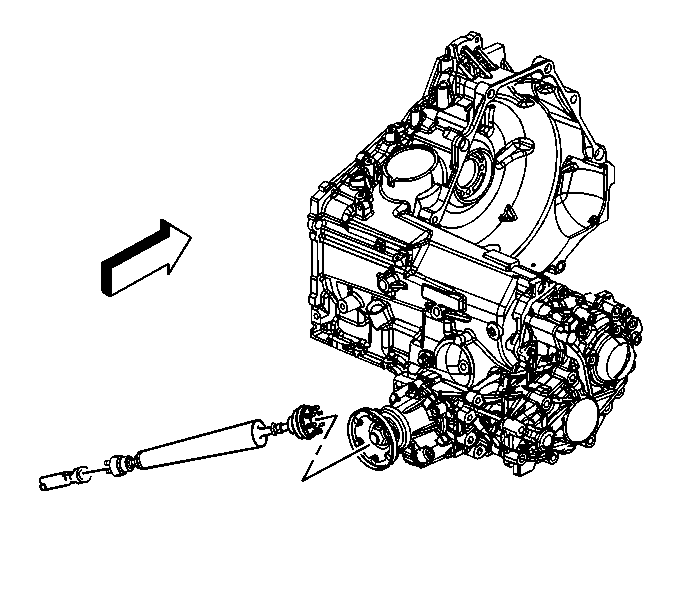
| 12.1. | Remove the propeller shaft. Refer to Propeller Shaft Replacement in Propeller Shaft. |
| 12.2. | Remove the transfer case brace. Refer to Support Brace Replacement in Transfer Case-Steyr. |
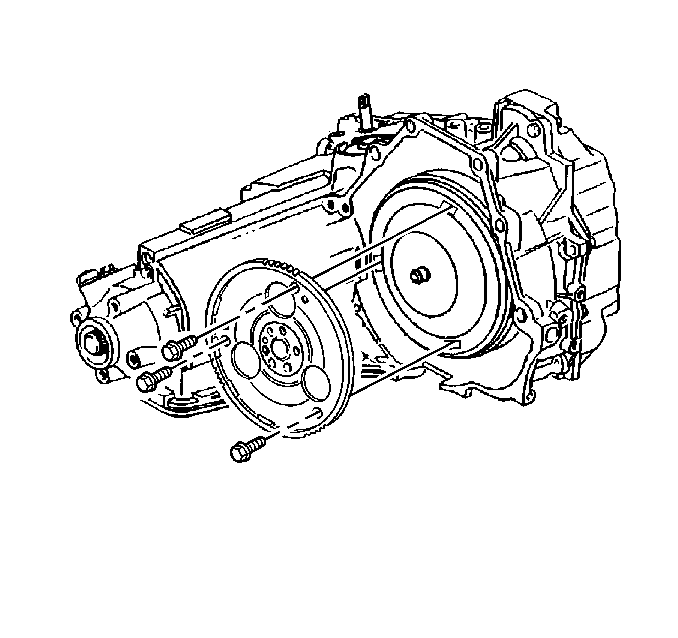

Installation Procedure
Important: If you are replacing the transaxle, transfer case or any internal components, you must inspect the end play and adjust as needed. Refer to Transmission to Transfer Case End Play Check in Automatic Transaxle - 4T65-E Unit Repair.
- If the vehicle is equipped with AWD, install the transfer case. Refer to Transfer Case Installation in Automatic Transaxle - 4T65-E Unit Repair.
- Position the flex plate alignment hole to the seven o'clock position.
- Align the transaxle filler tube to the transmission and install the transaxle into the vehicle.
- Install the lower transaxle bolt (6) and stud (1).
- Install the transaxle/transfer case brace. Refer to Transmission Brace Replacement .
- Install the transmission cooler hoses. Refer to Automatic Transmission Oil Cooler Hose Replacement .
- Install the right and left axle shafts into the transaxle. Refer to Front Wheel Drive Shaft Replacement in Wheel Drive Shafts.
- Connect the vehicle speed sensor electrical connector.
- Install the torque converter bolts. Refer to Flywheel to Torque Converter Bolt Replacement .
- Install the torque converter cover. Refer to Torque Converter Cover Replacement .
- Install the filler tube bracket bolt.
- Install the frame. Refer to Front Frame Replacement in Frame and Underbody.
- If the vehicle is equipped with AWD, perform the following steps:
- Install the front wheels. Refer to Tire and Wheel Removal and Installation in Tires and Wheels.
- Lower the vehicle.
- Remove the engine support fixture. Refer to Engine Support Fixture in Engine Mechanical-3.4L.
- Install the right side engine strut. Refer to Engine Mount Strut Replacement - Right Side in Engine Mechanical-3.4L.
- Install the upper transaxle bolts (3, 4, 5) and stud (2).
- Connect the wiring harness to the transaxle.
- Install the transmission range selector cable bracket. Refer to Range Selector Lever Cable Bracket Replacement .
- Install the automatic transmission range selector cable to the automatic transmission range selector lever. Refer to Automatic Transmission Range Selector Lever Replacement .
- Install the air cleaner assembly. Refer to Air Cleaner Assembly Replacement in Engine Controls-3.4L.
- Install the coolant recovery bottle.
- Inspect and adjust the transaxle fluid level as needed. Refer to the following information.
- Reset the TAP values. Refer to Transmission Adaptive Functions .

Notice: Use the correct fastener in the correct location. Replacement fasteners must be the correct part number for that application. Fasteners requiring replacement or fasteners requiring the use of thread locking compound or sealant are identified in the service procedure. Do not use paints, lubricants, or corrosion inhibitors on fasteners or fastener joint surfaces unless specified. These coatings affect fastener torque and joint clamping force and may damage the fastener. Use the correct tightening sequence and specifications when installing fasteners in order to avoid damage to parts and systems.
Tighten
Tighten the lower transaxle to engine and engine to transaxle bolts to 75 N·m (55 lb ft).


| 13.1. | Install the propeller shaft. Refer to Propeller Shaft Replacement in Propeller Shaft. |
| 13.2. | Install the transfer case brace. Refer to Support Brace Replacement in Transfer Case-Steyr. |

Tighten
Tighten the upper transaxle bolts and stud to 75 N·m (55 lb ft).


Important: It is recommended that the transmission adaptive pressure (TAP) information be reset.
Resetting the TAP values using a scan tool will erase all learned values in all cells. As a result, the ECM, PCM or TCM will need to relearn the TAP values. Transmission performance may be affected as new TAP values are learned.Transmission Replacement LY7
Tools Required
J 35944-A Transmission Oil Cooler Flusher
Removal Procedure
Important: Transmission oil circulates between the transmission assembly and the transfer case. In situations where transmission related failures circulate debris into the transfer case, the transfer case must be disassembled, cleaned, and inspected for damage.
- Raise and support the vehicle. Refer to Lifting and Jacking the Vehicle in General Information.
- Remove the transmission lower bell housing bolt located between the engine oil pan and the transmission oil pan.
- Remove the powertrain (engine, transmission and frame) from the vehicle. Refer to Engine Replacement in Engine Mechanical - 3.6L (LY7).
- Remove the filler tube. Refer to Transmission Fluid Filler Tube Replacement .
- Remove the transmission bell housing bolts (2).
- If the vehicle is equipped with all wheel drive (AWD), remove the transfer case brace. Refer to Support Brace Replacement in Transfer Case - Steyr.
- Remove the coolant inlet pipe. Refer to Radiator Inlet Hose Replacement in Engine Cooling.
- Remove the transmission mount with the transmission mount bracket. Refer to Transmission Mount Bracket Replacement .
- Remove the starter motor. Refer to Starter Removal in Engine Mechanical - 3.6L (LY7).
- Remove the torque converter bolts. Refer to Flywheel to Torque Converter Bolt Replacement .
- Remove the transmission lower brace. Refer to Transmission Brace Replacement .
- Remove the transmission upper brace nut located behind the power steering pump and above the transfer case.
- Remove the transmission bolt near the crank sensor and the engine coolant (block) heater.
- Separate the transmission from the engine.
- If the vehicle is equipped with AWD, remove the transfer case. Refer to Transfer Case Removal in Automatic Transaxle - 4T65-E Unit Repair.
- Flush the transaxle oil cooler and the transaxle oil cooler hoses. Refer to Transmission Fluid Cooler Flushing and Flow Test in Automatic Transmission - 4T65-E.
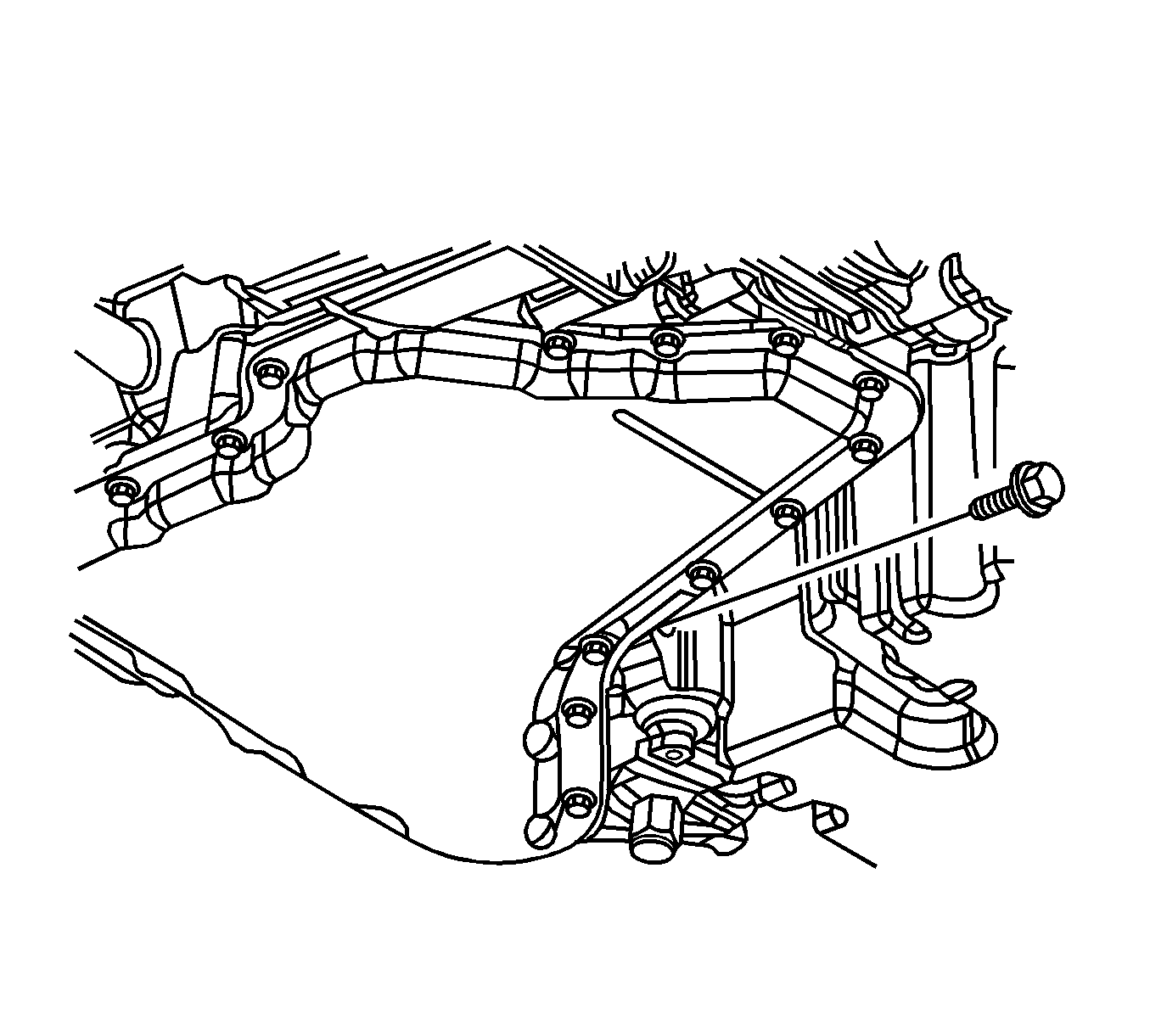
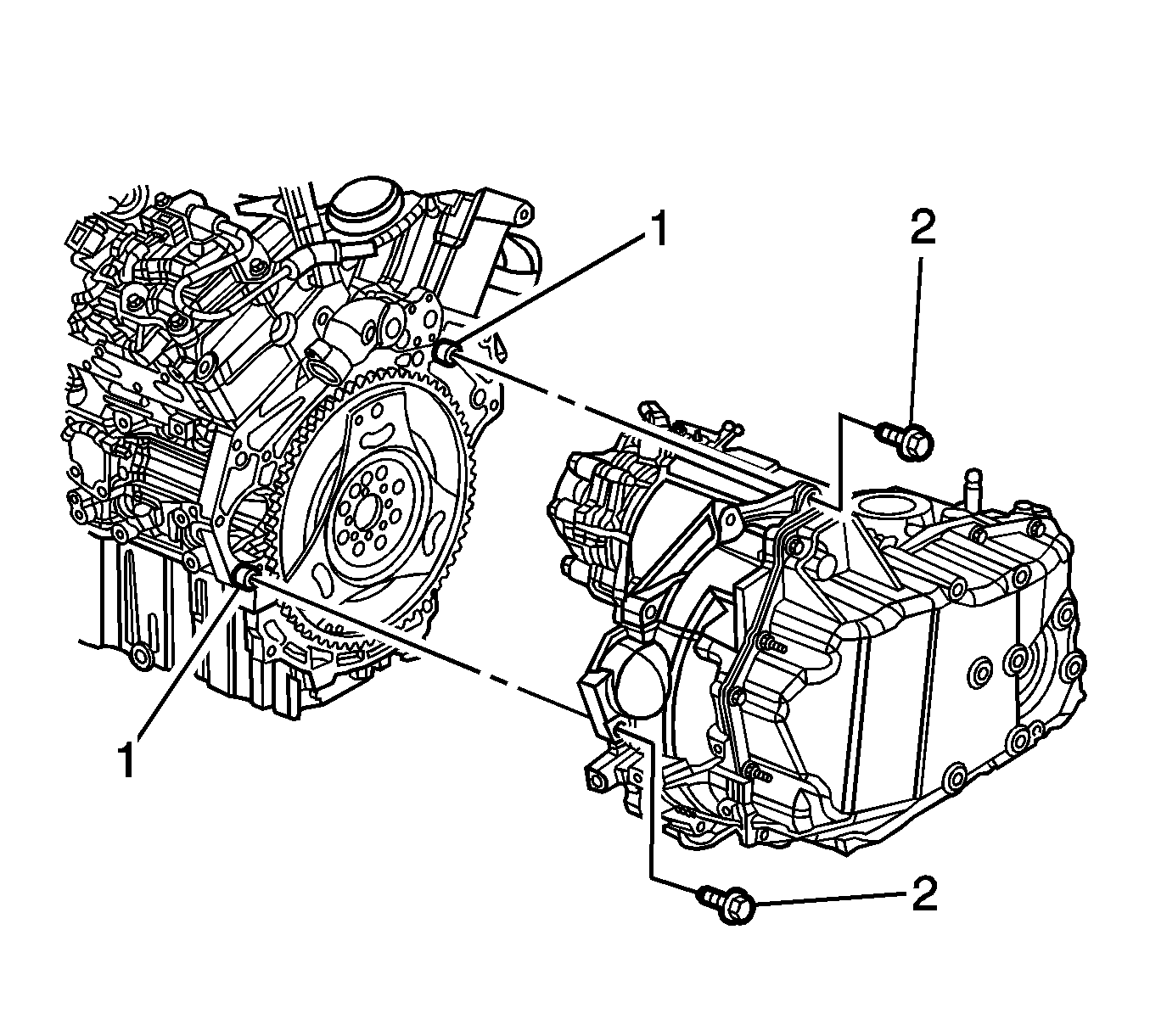
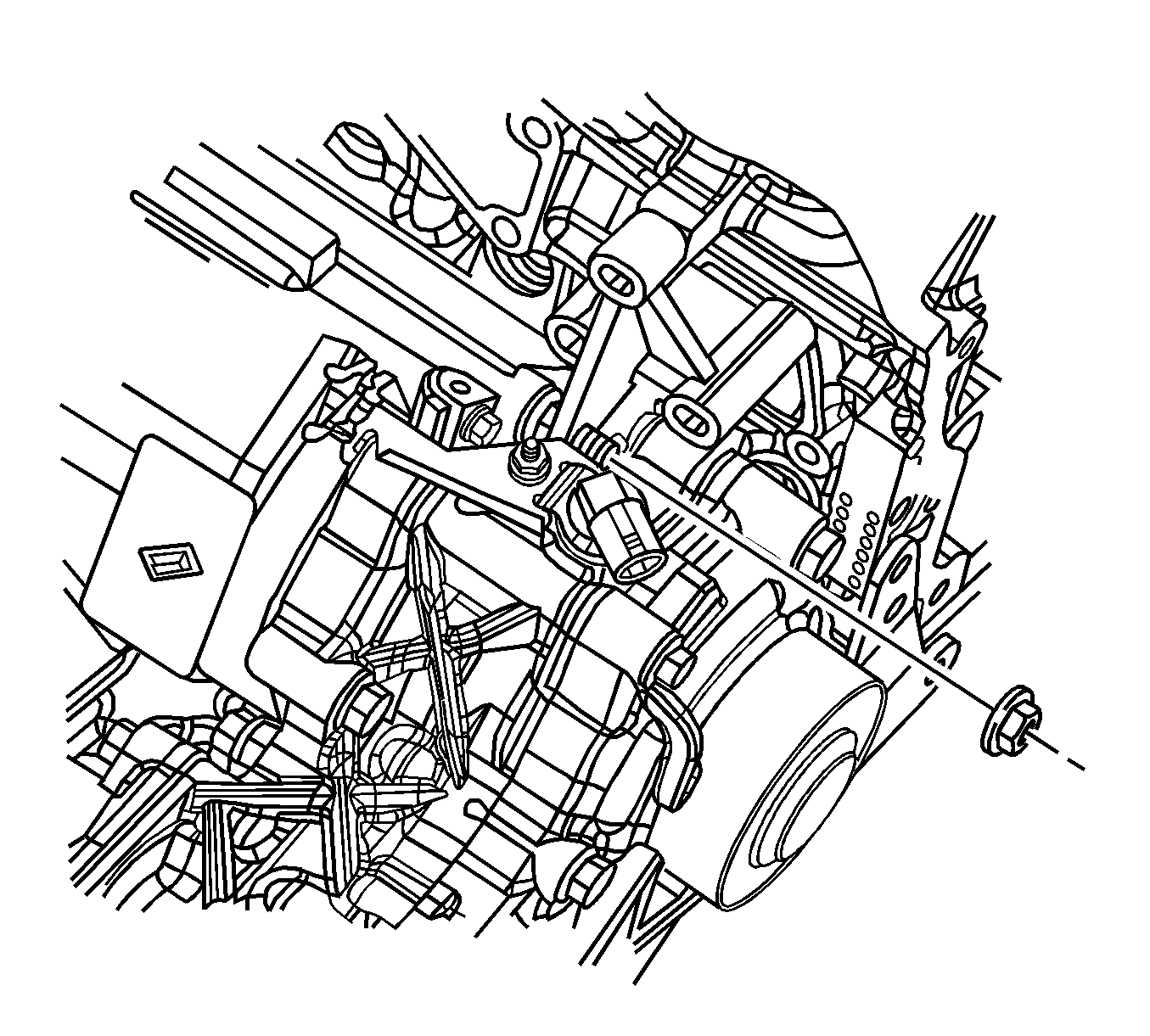

Installation Procedure
Important: If you are replacing the transaxle, transfer case or any internal components, you must inspect the end play and adjust as needed. Refer to Transmission to Transfer Case End Play Check in Automatic Transaxle - 4T65-E Unit Repair.
- If the vehicle is equipped with AWD, install the transfer case. Refer to Transfer Case Installation in Automatic Transaxle - 4T65-E Unit Repair.
- Use the dowel locator pins (1) in order to align and install the transmission to the engine.
- Install the transmission bell housing bolts (2).
- Install the transmission bell housing bolt near the crank sensor and the engine coolant (block) heater.
- Install the transmission upper brace nut located behind the power steering pump and above the transfer case.
- Install the transmission lower brace. Refer to Transmission Brace Replacement .
- Install the torque converter bolts. Refer to Flywheel to Torque Converter Bolt Replacement .
- Install the starter motor. Refer to Starter Installation in Engine Mechanical - 3.6L (LY7).
- Install the transmission mount with the transmission mount bracket. Refer to Transmission Mount Bracket Replacement .
- Install the coolant inlet pipe. Refer to Radiator Inlet Hose Replacement in Engine Cooling.
- If the vehicle is equipped with AWD, install the transfer case brace. Refer to Support Brace Replacement in Transfer Case - Steyr.
- Install the filler tube. Refer to Transmission Fluid Filler Tube Replacement .
- Install the powertrain (engine, transmission and frame) to the vehicle. Refer to Engine Replacement in Engine Mechanical - 3.6L (LY7).
- Install the transmission lower bell housing bolt located between the engine oil pan and the transmission oil pan.
- Inspect and adjust the transaxle fluid level as needed. Refer to the following information:
- Reset the TAP values. Refer to Transmission Adaptive Functions .

Notice: Refer to Fastener Notice in the Preface section.
Tighten
Tighten the transmission bell housing bolts to 50 N·m (37 lb ft).

Tighten
Tighten the transmission bell housing bolt to 50 N·m (37 lb ft).

Tighten
Tighten the transmission upper brace nut to 50 N·m (37 lb ft).

Tighten
Tighten the transmission bell housing bolt to 50 N·m (37 lb ft).
Important: It is recommended that transmission adaptive pressure (TAP) information be reset.
Resetting the TAP values using a scan tool will erase all learned values in all cells. As a result, The ECM, PCM or TCM will need to relearn TAP values. Transmission performance may be affected as new TAP values are learned.